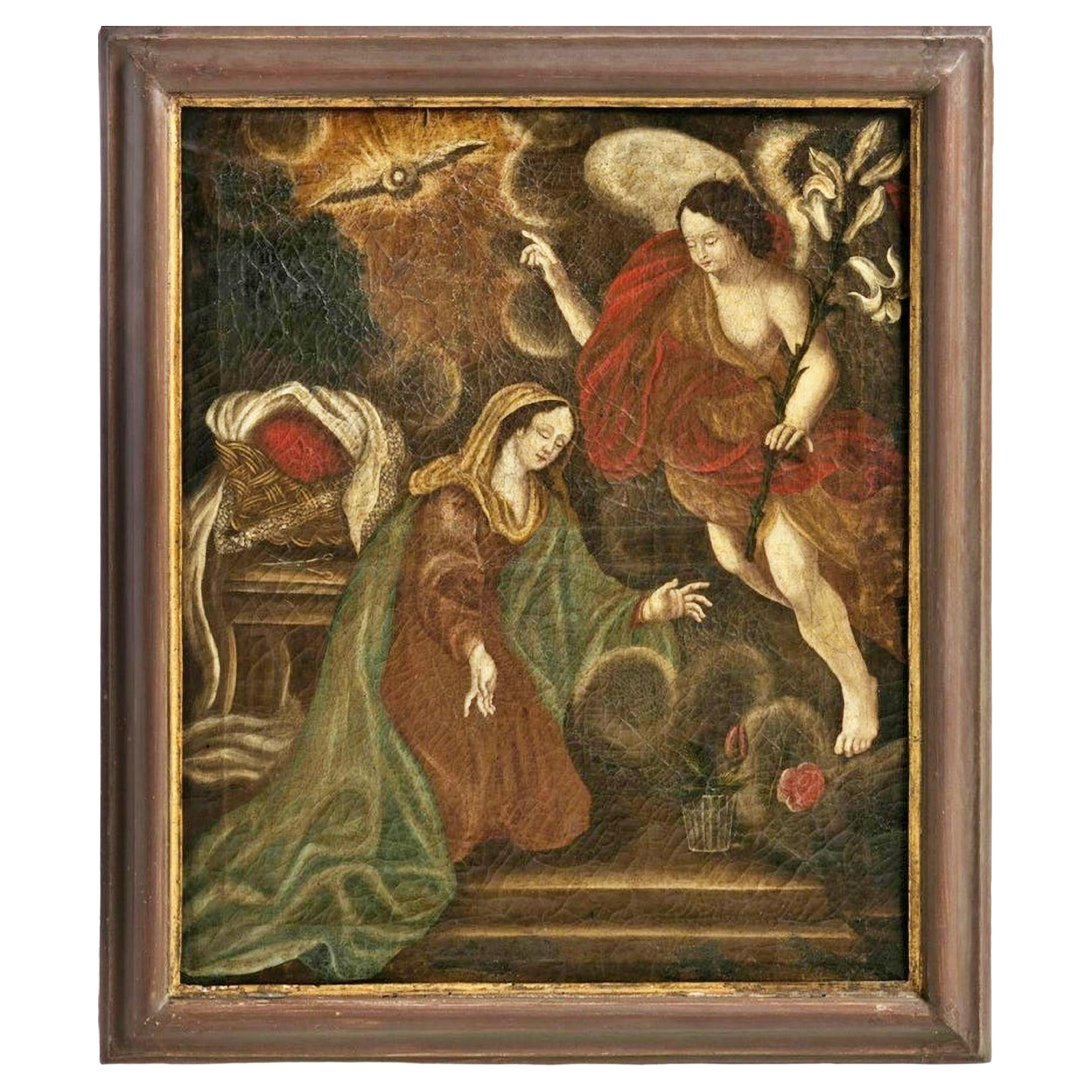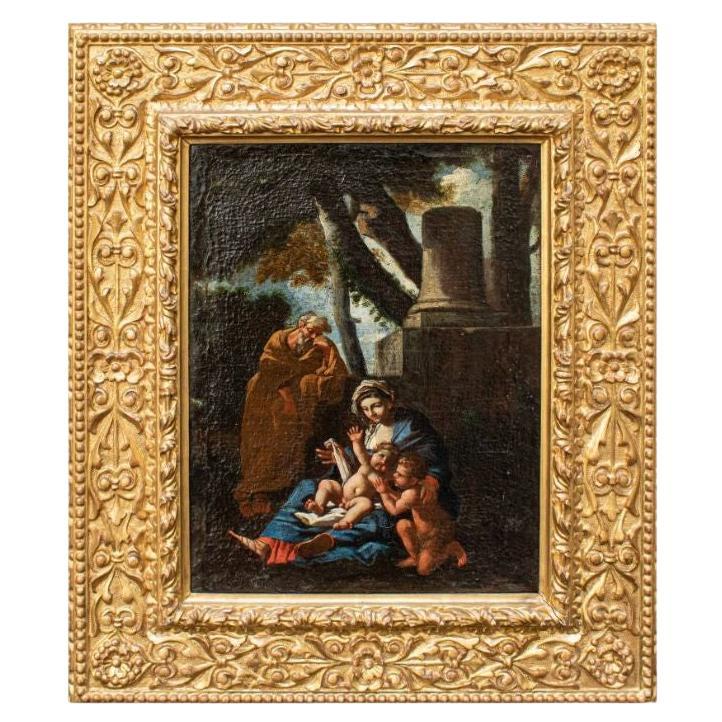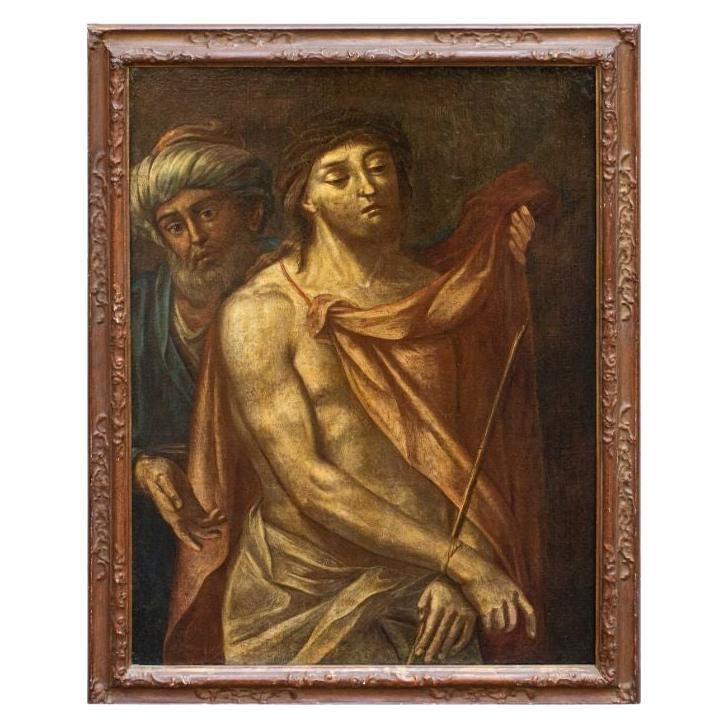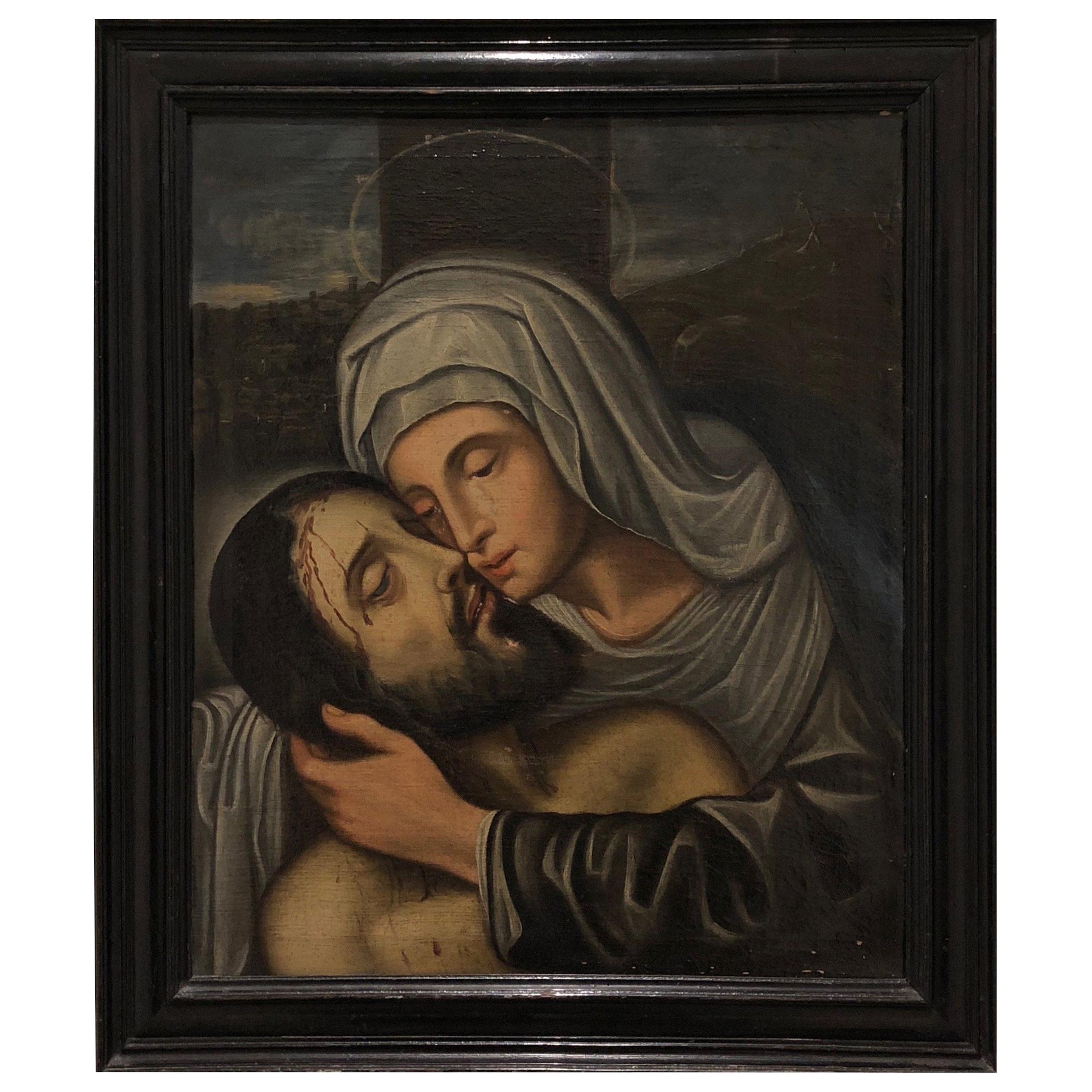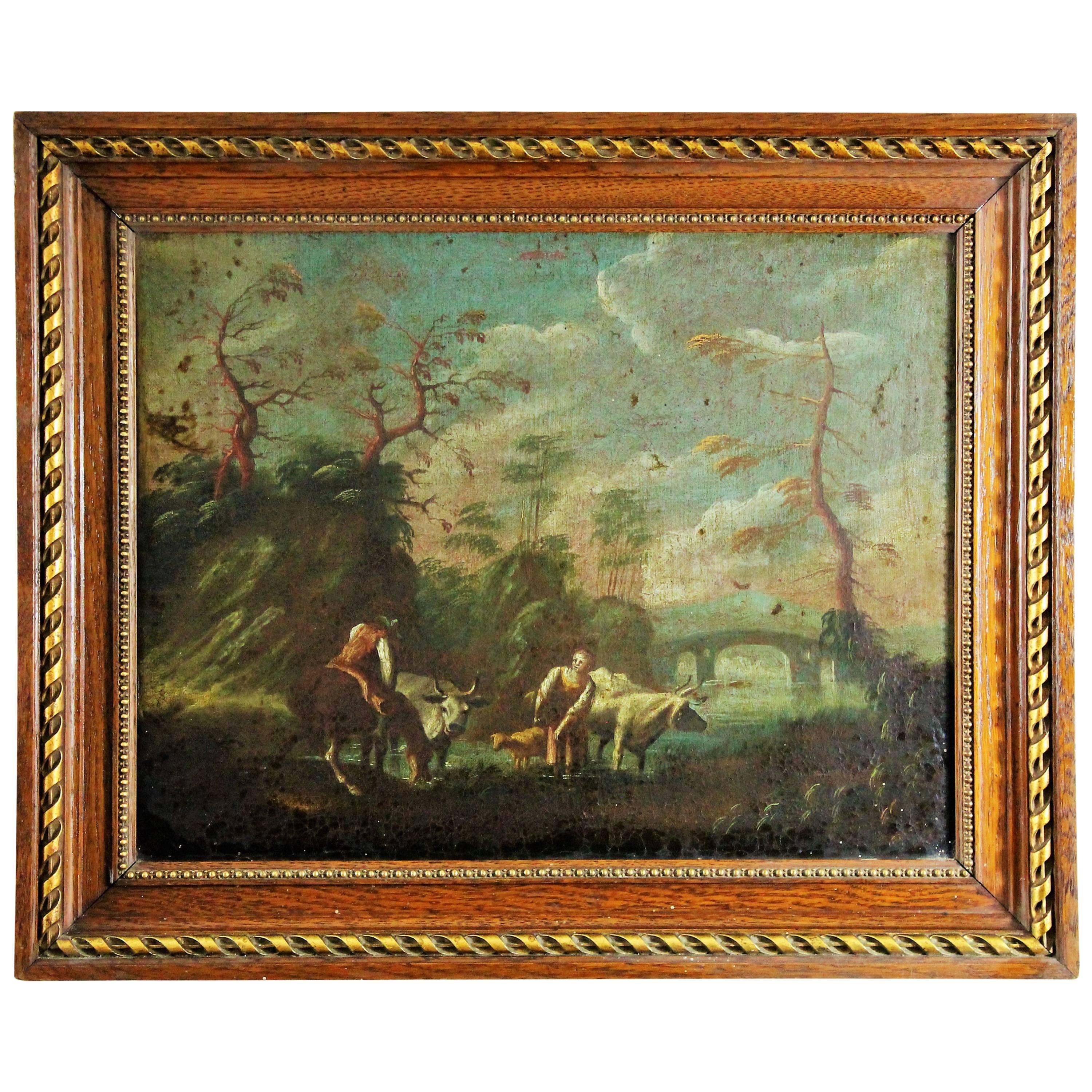Items Similar to Venetian school, Transport of Christ to the Sepulcher, oil on canvas 17th century
Want more images or videos?
Request additional images or videos from the seller
1 of 16
Venetian school, Transport of Christ to the Sepulcher, oil on canvas 17th century
About the Item
Venetian school, 17th century
Transporting Christ to the tomb
oil on canvas, 40 x 104.5 cm
The exhaustion of the late Mannerist currents that had matured within the capital work of Titian, Veronese, and Tintoretto provoked a general spirit of formal revival of the great masters. Not only the direct workshop pupils, but also the exponents of various artistic as well as regional guilds began to profess blind imitation, often not fully understanding the artistic motives of the great inspirers. The brightest and most forward-thinking exponents of the masters' tails were brought together by Boschini in the circle of the so-called seven manners. This Venetian genius, which began with Jacopo Negretti known as Palma the Younger (1548 ca-1628) in "strong and gangly" mode theoretically ended with Gerolamo Pilotti, who died in 1649, passing through Andrea Vicentino (1542 ca.-1617), Santo Peranda (1566-1638), Antonio Vassillacchi known as l'Aliense (1566-1629), Pietro Malombra (1566-1618), and Leonardo Corona (1561-1605). Palma the Younger was one of two most prolific Italian artists, surpassed only by Luca Giordano. On the strength of a sojourn in Urbino and the crucial Roman pause, Negretti preferred to reap the seedbed of Tintoretto rather than Titian: his personal declination of Venetian art, shaded by Roman hyperbole, nevertheless allows the present to be brought closer to some of his homologous works. A subject dear to the artist and replicated on several occasions, the painting in fact approaches the Mourning over the Dead Christ in the Venetian Academy Galleries in terms of the figuration of the little angels, similar to the one in the Gianni Bellini Civic Museum of Art and Territory in Sarnico. The Christ of the Civic Museum of Belluno, as well as that of the Fondazione Cassa di Risparmio di Reggio Emilia Manodori, approach instead the soft brushstrokes of the present, illuminated by a vibrant use of colors essayed on Venetian tonalism.
The fine color combinations, well calibrated between warm and cool tones used for the angels' robes, contrasting with the acid tones of Christ's complexion to emphasize his dead condition indicate the work's provenance from a painter belonging to the 16th-century Venetian school. References to that school can be discerned by comparison with the works of famous Venetian masters such as Tintoretto and Veronese, who in their paintings of a similar theme used to fill the space, with great theatricality, with characters, playing on chiaroscuro contrasts intensified by the often nocturnal setting that also accentuates the emotional charge of the subject, along with the use of particular shades of intense and sometimes acid colors. Competitively, the work finds similarities with Tintoretto's Lamentation over the Dead Christ where the pronounced positioning of Christ is discernible, surrounded this time by the pious women.
The item is in good condition
- Dimensions:Height: 41.34 in (105 cm)Width: 15.75 in (40 cm)Depth: 1.58 in (4 cm)
- Materials and Techniques:Canvas,Oiled
- Period:
- Date of Manufacture:unfamiliar
- Condition:
- Seller Location:Milan, IT
- Reference Number:1stDibs: LU5918238967202

About the Seller
5.0
Vetted Seller
These experienced sellers undergo a comprehensive evaluation by our team of in-house experts.
Established in 2000
1stDibs seller since 2021
25 sales on 1stDibs
Typical response time: 10 hours
- ShippingRetrieving quote...Ships From: Milan, Italy
- Return PolicyA return for this item may be initiated within 14 days of delivery.
More From This SellerView All
- 17th Century Christ and the Samaritan Oil on Canvas Roman SchoolLocated in Milan, ITRoman school of the 17th century Landscape with bridge - Christ and the Samaritan woman at the well Oil on canvas, cm 42 x 59,5 - With frame, cm 54, 5 x 71 cm The small canvas portrays a broad view of the city surrounded by a bucolic and lush landscape, probably a reinterpretation of the Roman countryside or the Agro. The fulcrum of the canvas is the bridge consisting of several bays beyond which stands a village. In the distance the landscape made of green mountains opens into what looks like a lake crossed by boats. The landscape is animated by the human presence; not only small and fleeting figurines intent on walking along earthy paths but also the representation, in the foreground, of an Gospel episode, that of Christ and the Samaritan woman at the well. The landscape can be clearly traced back to a painter trained on the examples of the great seventeenth-century Roman baroque landscape that sees in the Lunette Aldobrandini by Annibale Carracci but also in Claude Lorrain, Nicolas Poussin and Gaspar Doghet are its greatest achievers. If in the past, therefore, the landscape was considered the scenic background on which to project the representation of divine or human characters, in the seventeenth century it became an autonomous and codified pictorial genre. With Carracci comes the so-called ideal landscape: a mental reconstruction of a peaceful and harmonious nature in which the dream of a perfect communion with man is realized. In the wake of Hannibal, as mentioned, during the seventeenth century the "classic" Roman landscape knows a long and happy season by artists such as Domenichino, and the French Claude Lorrain, Nicolas Poussin and Gaspar Dughet. Lorrain investigates the Roman countryside in all its aspects, studying the variations in the different hours of the day, the seasons or weather conditions, but always nourished by a sense of bucolic Virgilian. With Poussin the approach becomes intellectual elaboration and sophisticated rational construction. From the examples of the great masters, the Roman Baroque season, from the middle of the century, saw the flourishing of several personalities who, with shots, but also important personal reworkings, led to further spread the genre. Among the personalities that can be compared to the work in question we cannot fail to mention Crescenzio Onofri (1634-1714), defined by Salerno as the only true pupil of Dughet, who then spread in Florence the taste of the Baroque landscape influencing Tuscan painters such as Panfi and Peruzzini. His paintings are in various Roman collections; such as, for example, the landscapes from the Sacchetti Collection and today at the Pinacoteca Capitolina. and those in the Almagià collection in Rome, others in the Palazzo di Montecitorio, but the most conspicuous group is in the Galleria Doria. In comparison we can mention the two passages of the National Gallery in London, the landscape with a bridge over the Antiquarian Market but also the design of the National Gallery of Art in Washington. In the work you can also find the influences of the art of Giovanni Francesco Grimaldi...Category
Antique 17th Century Italian Paintings
MaterialsCanvas
- 17th Century Rest on The Flight to Egypt Emilian school Painting Oil on CanvasLocated in Milan, IT17th century, Emilian school Rest on the flight to Egypt Oil on canvas, 42 x 33 cm Frame 65 x 55 cm The present Holy Family, ...Category
Antique 17th Century Italian Paintings
MaterialsCanvas
- 17th Century Christ in Chains Painting Oil on CanvasLocated in Milan, IT17th century Christ in chains Oil on canvas, 95 x 71 cm Frame 110 x 84 cm The figurative tradition representing Christ with chained hands can be traced back to the early Middle Ages, when an iconography of His pains spread widely. The need to translate the Passion into images aimed to raise awareness of the forgiveness that has occurred for all men, consequent to the Crucifixion. This painting depicts the moment before the audience before Pilate. Christ has not yet been cruelly mocked by the soldiers, despite the fact that he is already wearing the crown of thorns and the purple...Category
Antique 17th Century Italian Paintings
MaterialsCanvas
- Oil painting on canvas depicting Still life Roman school of the 17th centuryLocated in Milan, ITRoman School, 17th century Still Life Oil on canvas, 79 x 107 cm Framed, 93 x 121 cm The work under scrutiny, depicting a majestic still life of flowers, is ascribed to the 17th...Category
Antique 17th Century Paintings
MaterialsCanvas
- 17th Century Rest on the flight to Egypt Emilian School Painting Oil on panelBy ParmigianinoLocated in Milan, IT17th century, Emilian school, Pamigianino painter Rest on the flight to Egypt Oil on panel, 46 x 39 cm - with frame 55.5 x 48.5 cm The wor...Category
Antique 17th Century Italian Paintings
MaterialsWood
- 17th Century Live Nature Pair of Paintings Oil on Canvas Flemish SchoolLocated in Milan, ITFlemish School, 17th century Live nature couple with animals Measures: Oil on canvas, cm 25 x 35 - With frame cm 37 x 48 The pair of canvases in question depicts two excited...Category
Antique 17th Century Paintings
MaterialsCanvas
You May Also Like
- Announcement Italian School Oil on Canvas, of the 17th CenturyBy Europa AntiquesLocated in Madrid, ESAnnouncement Italian School Oil on canvas, of the 17th century Dimension: 75 x 62 cm. Good conditions.Category
Antique 17th Century French Baroque Paintings
MaterialsPaint
- Spanish School Early 17th Century Oil Painting of Christ and the Virgin MaryLocated in London, GBAn early 17th century painting in oil on canvas from the Spanish School depicting the Lamentation of Christ. In this moving depiction of the Lamentation Christ...Category
Antique Early 17th Century Spanish Renaissance Paintings
MaterialsPaint
- Oil on Canvas Paint Flemish School, 17th Century BelgiumLocated in Beuzevillette, FROil on canvas depicting a country scene: a man watering his horse near a river where two cows and a sheep wade accompanied by a farmer. Work of northern France or Belgium of the 17t...Category
Antique 17th Century Belgian Paintings
MaterialsCanvas
- 17th Century Oil on Canvas Italian Antique Religious Painting Christ, 1670Located in Vicoforte, PiedmontAntique Italian painting from the 17th century. Artwork oil on canvas depicting a religious subject, Jesus stripped of his clothes, scene of the passion of Christ of good pictorial q...Category
Antique Late 17th Century Italian Paintings
MaterialsCanvas
- 17th Century Venetian Oil PaintingLocated in Atlanta, GAAn outstanding and grand 17th century Baroque oil painting on an oval wooden panel of the Madonna and Child. Beautifully executed and stunning patina.Category
Antique 17th Century Italian Paintings
MaterialsWood
- Early 17th Century School of Peter Paul Rubens “The Holy Family” Oil on CanvasLocated in Doha, QAThis is an absolutely incredible early 17th century oil on canvas painting representing Holy Family-Virgin Mary, St.Joseph, St. Elisabeth, John the Baptist and Baby Jesus. Sir Peter ...Category
Antique Early 17th Century Italian Baroque Paintings
MaterialsCanvas

